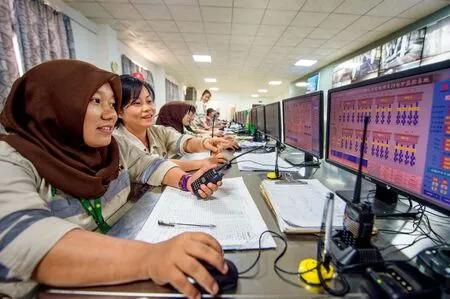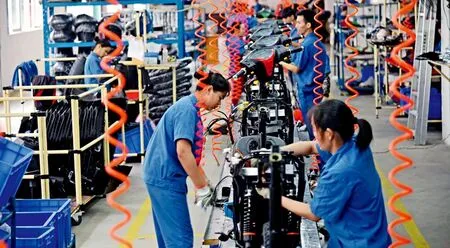REGIONAL INVESTMENT IMPROVES ECONOMIC,CULTURAL TIES
2017-11-22ByWangQin
By Wang Qin
As two-way investment surpasses US$185 billion, economic ties between China and ASEAN member states are closer than ever
REGIONAL INVESTMENT IMPROVES ECONOMIC,CULTURAL TIES
By Wang Qin
As two-way investment surpasses US$185 billion, economic ties between China and ASEAN member states are closer than ever

Indonesian workers at the Tsingshan Industrial Park in Central Sulawesi, Indonesia.
China’s relations with ASEAN member states have made rapid progress, especially in the areas of economic and trade cooperation. Chinese Ministry of Commerce statistics show that China and ASEAN are close economic and trade partners.For eight consecutive years,China has been ASEAN’s largest trading partner, while ASEAN has been China’s third largest trading partner for the past six years. Total two-way investment between China and ASEAN has surpassed US$185 billion. In the first seven months of 2017,China invested US$4.82 billion in ASEAN member countries.China’s total direct investment in ASEAN has reached US$76.8 billion. How have China and ASEAN been able to achieve so much?
Regional Integration
The progress of China-ASEAN regional economic integration has contributed to the development of economic and trade relations between the two sides. It has to a large extent promoted the establishment of bilateral cooperation frameworks and mechanisms, which have rapidly expanded the scale of the cooperation. Conversely,the development of the latter gradually upgrades regional economic integration. In recent years, there have been frequent exchanges of highlevel visits. A dozen ministerial level meeting mechanisms and over 20 senior official level cooperation mechanisms have been set up, which has further institutionalized and normalized regional cooperation.
The steady progress made in regional economic integration is inseparable from the building of the ASEAN-China Free Trade Area (ACFTA). In November 2015, China and ASEAN signed the ACFTA Upgrade Protocol, which marked a higher level of cooperation within the framework. ASEAN countries are now pushing forward industrialization and urbanization with strong demand for foreign capital, equipment and technology, while China has advantages in capital, technology and management. Within the framework of the upgraded ACFTA, relevant industries of the two sides can accelerate integration, which will eventually drive the industrial development of relevant ASEAN countries.The effective upgrading of ACFTA will also allow Chinese enterprises greater access to vast markets, convenient terms of trade and a better investment environment in ASEAN, which will vigorously boost bilateral economic cooperation and drive the economic development of both sides. That will help support the twin goals of reaching twoway trade and investment of US$1 trillion and US$150 billion,respectively, by 2020. From a macro-economic point of view, the effective upgrading of ACFTA will further accelerate the economic integration of the region and contribute to the realization of trade and investment liberalization in the Asia-Pacific region.
It is obvious that ACFTA has promoted the economic development of both China and ASEAN member states. It has expanded trade and investment between the two and promoted the flow of goods, capital and information among countries in the region. ACFTA has driven the development of the regional market and created more wealth which has improved the overall competitiveness of the region and brought tangible benefits to the peoples of the region.Benefiting from ACFTA, trade volume between China and ASEAN reached US$452.2 billion in 2016.


Top: Chairman of China UnionPay Su Ning (second right) and Board Chairman of the Bank of Thailand Ampon Kittiampon(second left) at the UnionPay debit card launch ceremony in Bangkok,Thailand, on Jan.22, 2013.
Above: Workers on an assembly line of the China-ASEAN New Energy Electric Vehicles Production Base in Guigang,Guangxi Zhuang Autonomous Region, on July 6, 2017.
Infrastructure Construction
Infrastructure construction has played an active part in China-ASEAN economic cooperation. In order to promote economic growth and improve the investment environment,ASEAN countries have accelerated their infrastructure construction. Many have worked out action plans on large- and medium-scale projects which will boost their economies.
At the end of 2014, the Indonesian government worked out a medium-term plan for 2015-2019, the key being to speed up large-scale infrastructure construction projects in 12 areas in the upcoming five years. The Thai government released its 2014-2022 national transportation infrastructure plan, covering railways,highways, waterways, aviation and urban rail transit, with a total investment of 2.4 trillion baht (US$68.5 billion). In terms of these areas of investment,railway projects are the most expensive. The Philippine government released its largescale infrastructure investment plan in April 2017. According to the plan, from 2017 to 2022,the Philippine government will invest 8.4 trillion pesos(US$168 billion) on infrastructure construction. The Singaporean government has also announced an infrastructure investment plan for the next 10 years. According to the plan, the main projects will include building a fifth terminal at Changi Airport, the Tuas Giant Wharf, the Singapore-Kuala Lumpur High-Speed Railway and a subway system connecting Woodlands and Johor Baru.Vietnam has also attached great importance to infrastructure construction to improve its investment environment.The Vietnamese government estimates that US$480 billion will be spent on its infrastructure development by 2020.
In recent years, Chinese technology in high-speed railways, housing and highways has been acknowledged by ASEAN countries. The development strategy of Chinese enterprises has also been accepted by ASEAN countries.That’s why ASEAN countries are ready to cooperate with Chinese enterprises in the planning for their infrastructure development.During this process, Chinese enterprises have achieved their goal of “going global”.
In July this year, the Joint Committee on Railway Cooperation between Thailand and China held its 11th round meeting. The two sides concluded negotiations on the design contract and the supervision contract price of the first phase of the China-Thailand Railway(Bangkok-Korat). To provide the Thai side with more support,the civil engineering work of the project will be its responsibility,and Thai equipment and raw material will be applied wherever possible. Meanwhile, a large number of Thai engineers and architects will be involved in design and supervision — which the Chinese side is responsible for. Technologies for high-speed railway construction, operation,maintenance and management will be transferred to the Thai side according to their needs. The resulting project is Thailand’s first standard gauge high-speed railway. The construction of this railway will add much to Thailand’s transportation system,allowing it to take on a better position as a transportation hub along the Indochinese Peninsula.The project will also stimulate the vitality of the Thai economy by driving the economic development of its northeast region and the economic corridor in its east. It will eventually bring more benefits to all countries along the line.
550billion
According to the People’s Bank of China, the quota of bilateral currency swap arrangements has reached 550 billion yuan(US$85 billion).The investment quota for ASEAN countries under its Renminbi Qualified Foreign Institutional Investors (RQFII)program has reached 200 billion yuan(US$30 billion).
30
ASEAN countries have set up more than 30 banking institutions in China, while Chinese banks have built more than 150 correspondent banks and correspondents of beneficiary banks with their ASEAN partners.
Industrial Capacity Cooperation
The ASEAN Economic Community Blueprint pointed out that to form a region with economies that are “vibrant,competitive and highly integrated”, the member states are expected to participate in global value chains (GVCs) to achieve scale economies and industrial agglomeration in an effort to promote the formation of a regional innovation system.GVCs and regional value chains (RVCs) are not mutually exclusive. The shaping and development of RVCs is key to ASEAN’s participation in GVCs.ASEAN has to push forward the integration and cooperation of regional industrial sectors, such as transportation, information and communication technology,e-commerce, energy, food,agriculture and forestry, tourism,healthcare, mineral resources and science and technology.
The industrial cooperation proposed by the Belt and Road Initiative includes industrial capacity cooperation among both traditional and emerging sectors,including agriculture, mineral resources, the marine industry,information technology, biology,new energy and new materials.Meanwhile, the Belt and Road advocates the improvement of the division of labor and distribution of industrial chains by encouraging the entire industrial chain and related industries to develop together, as well as establish R&D, production and marketing systems. The Belt and Road is also likely to lead to improvements in industrial supporting capacity and the overall competitiveness of regional industries, while also advocating the construction of various forms of industrial parks including overseas economic and trade cooperation zones and cross-border economic cooperation zones. These help to promote industrial cluster development. Thus, to promote bilateral industrial cooperation,the Belt and Road synergizes with ASEAN’s development in many ways. If the two sides can carry out diversified cooperation within the framework of the Belt and Road, there will certainly be new highlights that will better serve the development of each country.
Bilateral financial services cooperation between China and ASEAN, for example,has achieved fruitful results.According to the People’s Bank of China, the quota of bilateral currency swap arrangements has reached 550 billion yuan(US$85 billion). The investment quota for ASEAN countries under its Renminbi Qualified Foreign Institutional Investors(RQFII) program has reached 200 billion yuan (US$30 billion).The Asian Bond Fund (ABF) has played a part in improving Asia’s infrastructure construction.Meanwhile, an increasing number of financial institutions have been established in partner countries, with increasing amounts of capital injected into relevant projects. So far, ASEAN countries have set up more than 30 banking institutions in China,while Chinese banks have built more than 150 correspondent banks and correspondents of beneficiary banks with their ASEAN partners.
With the strengthening of ASEAN-China cooperation and the further implementation of the Belt and Road, bilateral industrial cooperation will be more diversified, which will bring new impetus to bilateral economic and trade cooperation.
About the author:
Wang Qin is a professor at Xiamen University’s Southeast Asian Research Institute.
